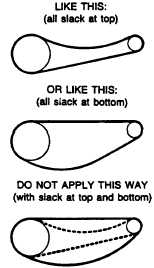TM 5-3895-374-24-2
Installation/
Tensioning V-Drives
Installing A Drive
Here are a few suggestions to keep in mind when
installing the drive:
1.
Use a matched set of belts.
2.
Clean oil and grease from the sheaves; remove any
rust or burrs from the sheave grooves.
3.
Shorten the center distance of the drive until the
belts can be put on the sheaves without forcing.
4.
Make sure that the sheaves are correctly aligned,
that the shafts are parallel, that there is clearance for
the drive to run and that the bearings have oil.
5.
Work belts around in the groove by hand, so that the
slack of all belts is on the top, or slack of all belts is
on the bottom.
Do not apply with the slack of some belts on the
bottom (see solid line) and the slack of others on the
top (see dotted line). Since V-belts will not slide in
the groove, belts thus applied will be injured when
tightened for operation.
Now tension the drive until only a slight bow appears
on the slack side of the belts when they are
operating.
6.
In a day or so, when the belts have had time to seat
in the grooves, re-tension the belts.
All V-belt drives should be guarded in much
a manner as to comply with the Williams-
Steiger Occupational-Safety and Health Act
and with all state and local laws and the
American National Standard Institute (ANSI)
Safety code.
Tensioning The Drive
General Rules of Tensioning:
1.
Ideal tension is the lowest tension at which the belt will
not slip under peak load conditions.
2.
Check tension frequently during the first 24-48 hours of
run-in operation.
3.
Over tensioning shortens belt and bearing life.
4.
Keep belts free from foreign material which may cause
slip.
5.
Make V-drive inspection on a periodic basis. Tension
when slipping.
Test The Tension
If you want to check the tension in a conventional V-belt
drive, use the procedure below:
1.
Measure the span length, t.
2.
At the center of the span (t) apply a force (perpendicular
to the span) large enough to deflect the belt 1/64" for
every inch of span length. For example, the deflection
of a 100 inch span would be 100/64 or 1 9/16 inches.
3.
Compare the force you have applied with the values
given in Table 12. If the force is between the values for
normal tension, and 1-1/2 times normal tension, the
drive tension should be satisfactory. A force below the
value for normal tension indicates an under tensioned
drive. If the force exceeds the value for 1-1/2 times
normal tension, the drive is tighter than it needs to be.
A new drive can be tightened initially to two times
normal tension to allow for the normal drop in tension
during run in.
Installation and Take-up Allowance
After calculating a center distance from a standard pitch
length, make provision for adjusting the center distance
as in Table 13, to allow for installation of the belts
without injury, for tensioning, and for maintenance of
proper tension throughout the life of the belt.
page 3 - 688



